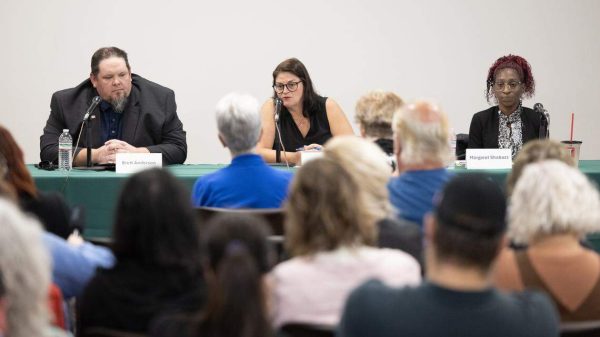Wichita’s aviation history is rich, but the industry faces unprecedented challenges
As the Air Capital of the World, Wichita has a long and storied history with aviation.
Because aviation is a cyclical industry prone to highs and lows over time, Wichita has had to navigate its economic peaks and valleys.
A significant low arrived in 2020, with COVID-19 shutting down large portions of the world, which came on top of layoffs due to the halt in production of the Boeing 737.
Since the outbreak, Textron Aviation has furloughed roughly 7,000 employees and instituted shortened work weeks for some employees. According to The Wichita Eagle, Spirit AeroSystems has also endured massive furloughs, putting thousands of aircraft employees out of work.
The International Air Transport Association revealed on April 14 that it anticipates a $314 billion revenue hit in 2020, mostly from passenger revenue losses.
Jay Price, chair of the Wichita State History Department, said he fully anticipates COVID-19 having a lasting impact on the aviation industry.
“This is going to change everything in terms of how people are traveling,” Price said weeks before Textron furloughed their employees.
He said commercial aviation will be hit the hardest.
“That’s going to be taking the humongous hit,” Price said.
Throughout the history of aviation in Wichita, there is really no comparison to COVID-19.
Wichita’s rich aviation history dates back to the 1910s. According to Richard Harris, an aviation industry analyst and historian, the early stages of Wichita’s aviation history can be tied to ballooning. The Wichita Aero Club was founded in 1915 and took the initiative to sponsor a balloon race in the fall of that year.
One significant figure in Wichita aviation was Clyde Cessna, a farmer from Rago, Kansas, who built his first plane in 1911. He eventually moved his airplane manufacturing business from Kingman County to the Jones Auto Factory in North Wichita.
In 1917, Cessna built The Comet, the first plane known to have been constructed in Wichita. In 1920, the E. M. Laird Airplane company was formed in Wichita by Maddie Laird, Jake Moellendick, and Billy Burke.
In 1921, according to the Kansas Aviation Museum, it is believed that William Lassen remarked, “She flies like a swallow, boys,” while observing the Laird Airplane Company’s first test flight of the Wichita Tractor, the group’s first airplane. The plane became known as the Laird Swallow from that point on.
In the late 1920s, Wichita had four aircraft companies — Swallow, Travel Air, Cessna, and Stearman. By 1928, the combined output of all four companies exceeded the aircraft production of any other city in the United States.
Every year, the Aeronautical Chamber of Commerce awarded the title “air capital city” to the city producing the most airplanes. In 1928, Wichita earned the honor. From then on, Wichita began promoting itself as “the Air Capital of the World.” Wichita would dominate the award in the following years.
Aircraft companies enjoyed a boom during World War II as thousands of aircraft workers found jobs in Kansas, mostly in Wichita.
During the war, Boeing built B-29 bombers. Beech and Cessna also built military aircraft, and many companies worked together to build gliders.
Wichita’s contributions to the war effort were significant. According to Harris, Wichita produced one out of every 11 U.S. military planes, absorbing workers from throughout Kansas and surrounding states, and nearly doubling the city’s population.
This created one of the highest concentrations of skilled aircraft workers in the world.
Wichita was awash in machine shops, aviation schools, aircraft instrument manufacturing, and other enterprises crucial to the success of aircraft manufacturers, all of which was enthusiastically backed by the business community, the local government, and academic communities.
Wichita’s success was secured. It became Boeing’s main bomber factory throughout the Cold War, then produced the bodies or fuselages of the world’s most popular jetliners, while Beech came to dominate business aircraft, and Cessna became the unrivaled world leader in light aircraft. Wichita’s pool of skill would later draw Learjet (1963) and Airbus Engineering (2002) to the city.
But then, after 80-plus years, Boeing announced its departure from the city in 2012. The move affected 2,100 workers in Wichita and left the city devastated.
Price said the symbolism of the move weighed heavily on the community.
“You had these big companies that were a presence, and they invested in the economy, and then they’re not there anymore. That played a difference,” Price said.
Harris said he suspects COVID-19 is leading business executives and other wealthy individuals to consider turning to private planes for travel.
The first five months of 2020 have provided a number of challenges for Wichita’s aviation industry. In January, Spirit AeroSystems, Wichita’s biggest employer, laid off approximately 2,800 workers due to the suspension of Boeing 737 Max production following several high-profile crashes.
David Moreno, the archivist at the Kansas Aviation Museum, said it’s hard to compare the current situation to others because of the circumstances. Moreno said he believes the difference between the Spirit layoffs and previous employment contractions is that the layoffs are due to a regulatory issue as opposed to an economic issue.
He said the future of the situation with the 737 Max and Spirit AeroSystems is dependent on a number of factors that are currently unknown.
“It’s a question of how soon does the plane get ungrounded, and how well accepted that plane will be afterwards,” Moreno said. “In other words, will the passengers be willing to get back on that airplane? And, therefore, will the airliners be willing to continue to buy that airplane?”
Price said layoffs are normal, but this situation is uniquely disconcerting.
“We were really used to that sense of a cycle, and when the recent layoffs happened, it’s like, ‘Oh, wait a minute. This isn’t the cycle,’” Price said.
Jeremy Hill, director of WSU’s Center for Economic Development and Business Research, said Wichita will have to fight to maintain its talent. He said other companies in the region will want to hire the laid-off workers, who may or may not be tempted if the pay is lower than what they previously earned.














Richard Harris - harris1.net • Dec 15, 2020 at 2:21 am
Emil Matthew “Matty” Laird — not “Maddie Laird” — was the designer of Wichita’s (and America’s) first successful commercial airplane: The Laird Swallow. That was the beginning of real success in aviation for Wichita (though Clyde Cessna’s Sept.1916 move to Wichita is generally regarded as the start of Wichita’s aviation industry.
Young Matty Laird was lured from Chicago to Wichita by a couple of oil men — Jacob Moellendick and his buddy Billy Burke, two Oklahoma oilmen who had struck it rich in the nearby Butler County oilfields during their 1915-1920 oil boom. They had a flying service with common war-surplus 2-seat biplanes, but realized Matty’s design was better: 3 seats, shorter wings, less drag, and faster. The Laird design concept, with more seat-miles-per-gallon, revolutionized the economics of U.S. aviation, quickly followed by other competitors. But he had no money to build it. Moellendick offered to fund the enterprise, if Laird would set up shop in Wichita.
Laird obliged, and moved here, in 1919, and the rest is history. Laird’s buddy, Buck Weaver, joined him. But Moellendick was a difficult partner. Though young Laird was officially “President” of the E.M. Laird Manufacturing Co., bully Jake was the chief funder, and forced his will on all — sometimes allegedly with the threat of physical force.
First, Jake he drove off Weaver, who returned to Chicago, then joined three colleagues in Ohio to start Weaver Aircraft Co. (“WACO” as it became known), the next big name in 3-seat biplanes — which would dominate the mid-1920s. Then Jake drove off Laird, who took his company name and a couple of planes back to Chicago, where he became famed for fast planes, including historic racers.
Jake was forced to restructure the Wichita enterprise — renaming it “Swallow Airplane Co.” (or variations thereof), and promoting recent new hires salesman/demonstrator pilot Walter Beech (to General Manager and Chief Salesman), and draftsman Lloyd Stearman (to Chief Engineer). Stearman revised the Swallow into the better, faster New Swallow, and sales resumed. But when Beech and Stearman pestered Moellendick to let them switch from wood-framed planes to metal-framed planes (to keep up with the emerging competition), Moellendick refused to allow it — telling Stearman and Beech to leave if they didn’t like it.
They left, in 1925, along with Swallow production manager Bill Snook, to start their own company — Travel Air Mfg. Co. — with support from an old Wichita barnstormer/farmer (who had gone back to the farm during World War II, and made a fortune): Clyde Cessna. More support came from Wichita’s pre-eminent merchant family: the Innes family. Walt Innes was the interim president, eventually handing the presidency off to Cessna. The Cessna/Beech/Stearman trio produced and promoted the most popular biplanes of the time: Travel Air A/B/2000/3000/4000, and gradually graduated to cabin biplanes and monoplanes, including the historic ocean-spanning 5000, and early 6-seat “airliner” the 6000. Stearman left to start his own line of biplanes, then Cessna left to start his own line of sleek monoplanes — leaving Beech at Travel Air.
The 1927 trans-Atlantic solo of Charles Lindberg stimulated a global aviation craze, and money flooded in to aviation, recklessly. Wichita, already with four prominent planemakers — Swallow, Travel Air, Stearman and Cessna — out-produced every other plane-making city in America, in sheer numbers of aircraft, in 1928. So the title “Air Capital City” was awarded to Wichita, by the nation’s Aeronautical Chamber of Commerce, that year, and Wichita managed to keep the title for generations thereafter, fairly consistently out-producing every other plane-making city in America.
Wichita State University became (allegedly) only the third university in the nation to have an aeronautical engineering program, and among its graduates were people who would reshape the city’s industry to keep up with the times (most famously, Clyde Cessna’s nephew, Dwane Wallace).
But the unregulated, reckless investing and spending of the 1920s (including sloppy investing — gambling — in the aircraft industry) led to the 1929 stock-market crash, and the 1930s Great Depression. Aircraft companies (including Wichita’s) were clobbered. Through a series of business dramas, Travel Air essentially became Beech Aircraft CO. (Beechcraft). and Stearman Aircraft became Boeing-Wichita (today’s Spirit Aerosystems).
Depression-era government stimulus money revived Beech, which leapt into modern, light, efficent, all-aluminum, hollow-shell, airplanes, and Cessna found a market for its new light twin-engine 5-seat Bobcat, World War II brought fortune back to Wichita. Throughout World War II, Wichita boomed (especially at Boeing), making trainers, light transports, combat invasion gliders, little Culver trainer/drones, and — most importantly — the war’s most sophisticated U.S. combat aircraft: the Boeing B-29 Superfortress heavy bomber (the largest of four factories, nationwide — building 44% of them, about 1,600 in all).
After the war, boom-and-bust cycles became the norm, as Wichita’s factories gained and lost in the wild swings characteristic of the airplane manufacturing industry. But while most of the lightplane industry collapsed, Cessna and Beech survived, and came to global dominance. Culver engineer Al Mooney started a soon-famous line of fast light planes, but was crowded out of booming Wichita, and moved to Texas. But electronics/aviation pioneer Bill Lear came here to build the first popular business jet: the iconic Learjet, in 1963. His design forced Beech and Cessna to up their game, eventually offering “bizjets” as well.
At Wichita’s postwar peak, in the 1960s/1970s, Wichita was producing MOST of the world’s light aircraft, and all of the final models of the B-52 Superfortresss intercontinental jet bombers (including all B-52s that still fly today).
Today, Wichita’s Beech and Cessna have merged, under Cessna’s parent, Textron Corp. Canadian train/plane-maker Bombardier owns, and continues, Lear Jet production. All three have their main global aircraft-maintenance facilities here, as well. Over 200 support enterprises — aluminum foundries, machine shops, plastics and carbon-fiber fabricators, small-parts manufacturers, instrument shops, aircraft maintenance shops, and industrial tool suppliers — round out the aerospace manufacturing power of the city.
And Boeing managed to break its union contracts by selling off Boeing-Wichita to a newly-formed partner: Spirit Aerosystems, which continues Boeing-Wichita’s previous production of jetliner sub-assemblies (most of the Boeing 737 series, including all of their fuselages, forward fuselages of all Boeing planes, and various other parts), and Europe’s Airbus has its North American engineering headquarters here, at Wichita State University, exploiting the city’s unusual wealth of aerospace expertise.
McConnell Air Force Base is one of the nation’s main bases for aerial tanker jets, and Wichita’s Eisenhower Airport provides connections to the world through most major airlines. More than a dozen other airports spread aviation services in and around Wichita, including flight training, air ambulance and charter services. The world’s leading pilot/mechanic training organization, Flight Safety International, has several of its busiest training centers here. Wichita State University’s “WSU Tech” has its National Aviation Training Center for training licensed aircraft technicians and factory craftsmen.
And WSU’s Engineering Dept. turns out Mechanical, Electrical, Industrial and Aerospace engineers, up to the Ph.D. level. The Kansas Aviation Museum hosts one of the largest collections of Kansas-built planes in the world, and especially one of the largest collections of whole Boeing jets civilian and military.
Some say the city is TOO much into aviation — leaving it utterly at the mercy of a largely unpredictable boom-and-bust industry. Others simply like that the money is good when production is in demand. But Wichita has, particularly in “bust” times, made an effort to diversify its industrial and commercial activity beyond its dependence upon aviation — with some success. Still, Wichita prides itself on its claim to be “Air Capital of the World” — even it it’s not always the highest-volume producer of aircraft — remaining a legendary and still-influential center for the world’s aerospace industry.
Richard Harris
member, American Aviation Historical Society
former Chairman, Wichita Aviation Centannial
http://harris1.net